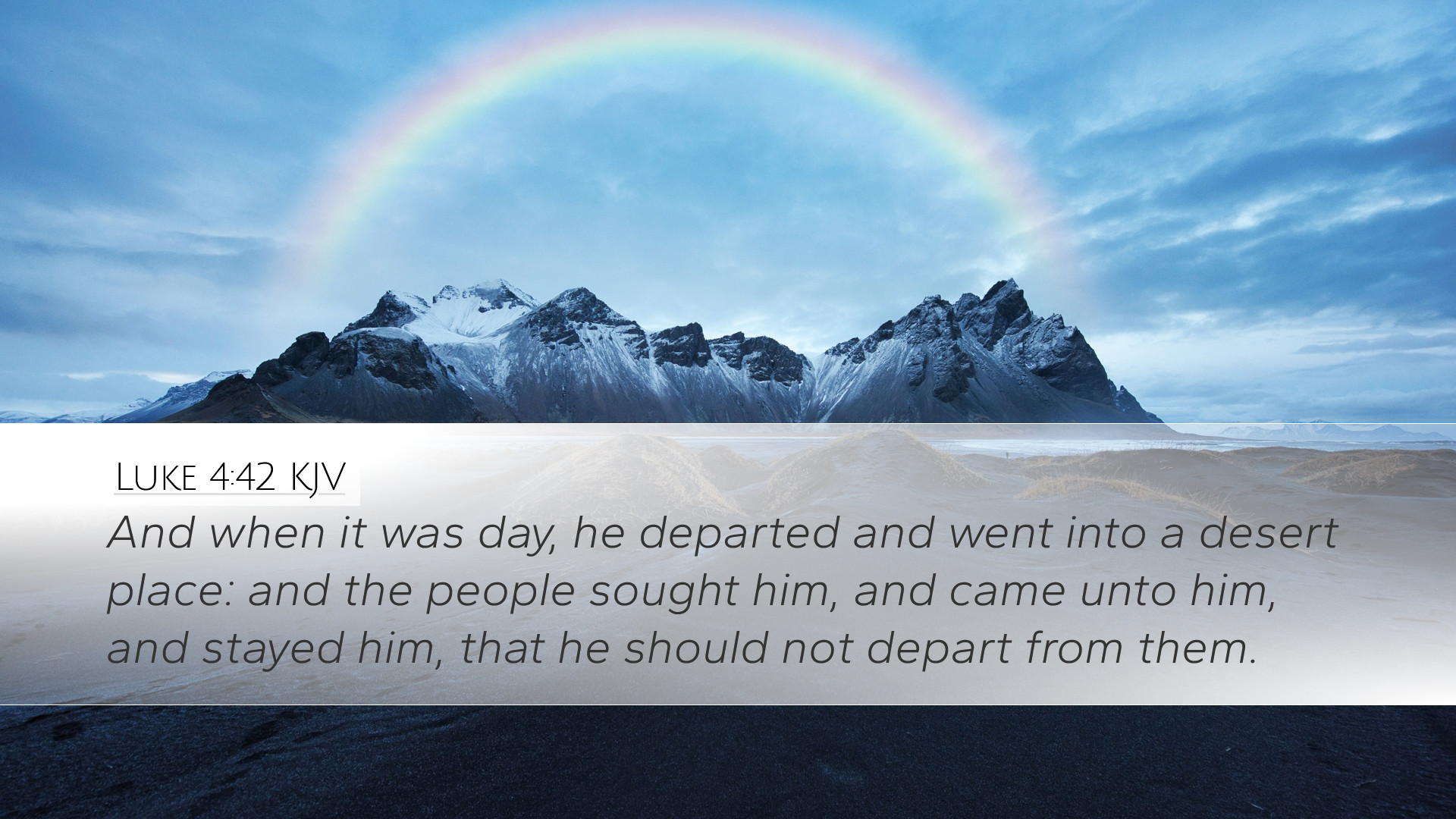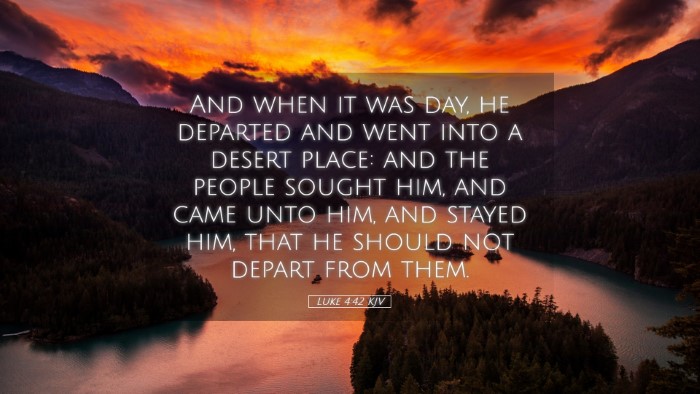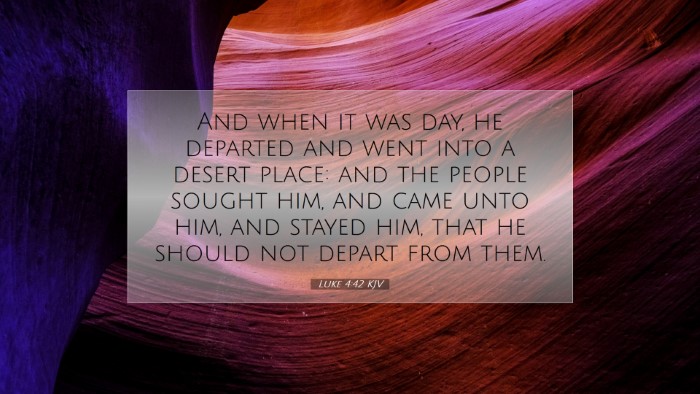Commentary on Luke 4:42
Luke 4:42 states: "And when it was day, he departed and went into a desert place: and the people sought him, and came unto him, and staid him, that he should not depart from them."
Introduction
This passage from the Gospel of Luke presents a pivotal moment in the early ministry of Jesus. It highlights both His human need for solitude and the people's desperate desire for His presence. This duality serves as a profound subject for reflection among pastors, students, theologians, and Bible scholars.
Contextual Background
In the broader context of Luke 4, we find that Jesus has just been in Capernaum, where He performed several miracles, including healing Simon Peter's mother-in-law and casting out demons. The events described culminate in the day following these activities, providing essential insight into both the character of Jesus and the nature of His ministry.
Daybreak: A Time for Solitude
“And when it was day...” (Luke 4:42a). The mention of daybreak indicates a moment of transition, symbolizing new opportunities and revelation.
- Matthew Henry notes that this illustrates the necessity for Jesus to withdraw from the clamoring crowds to seek communion with the Father.
- Albert Barnes comments on the importance of personal prayer and spiritual refreshment, emphasizing that even the Son of God required solitude to recharge and refocus before continuing His mission.
- Adam Clarke elaborates that this withdrawal to a “desert place” signifies the importance of retreat for spiritual rejuvenation, akin to the practices of many saints who sought solitude for prayer and meditation.
The Desert Place: Symbolism of Solitude
The “desert place” (4:42b) serves as a metaphor for spiritual desolation and communion with God, away from distractions.
- Matthew Henry elaborates that the desert symbolizes a place of trial and solitude that offers clarity and direction, contemplating the spiritual wilderness that Jesus and, by extension, His followers traverse.
- Barnes points out that Jesus' retreat is not merely physical but represents an inner journey to seek divine guidance and restore His spirit.
- Clarke expands on the concept of the wilderness as a traditional space for divine encounters, bringing to mind figures such as Moses and Elijah who also sought God in isolation.
The People's Pursuit
“And the people sought him, and came unto him, and staid him, that he should not depart from them” (Luke 4:42c).
This verse illustrates the fervent desire of the people to keep Jesus with them, not only for their physical needs but also for spiritual fulfillment.
- Henry observes the tenacity of the crowd, which represents humanity's innate longing for the divine and the need for healing, guidance, and hope.
- Barnes reflects on the desperation of the people, symbolizing societal yearning for a savior amidst life’s struggles, portraying their spiritual blindness in wanting Jesus only for His miracles.
- Clarke notes that their clinging to Jesus signifies a lack of understanding of His greater mission, emphasizing the tension between temporal need and spiritual purpose.
Application for Modern Readers
This passage has numerous applications for contemporary followers of Christ:
- Importance of Solitude: Just as Jesus withdrew for prayer, modern believers are called to set aside time for personal devotion, reflection, and communion with God.
- Pursuit of Jesus: The eagerness of the people to remain with Christ serves as a mirror for believers today, inspiring an ongoing pursuit of Jesus beyond the initial experience of faith.
- Balancing Ministry and Personal Spiritual Life: Pastors and ministers must navigate the demands of serving others while also prioritizing their spiritual health through regular retreat and prayer.
Theological Reflections
This passage not only depicts a moment in Jesus' ministry but invites deeper theological contemplation:
- Humanity of Christ: It demonstrates Jesus’ humanity as He sought rest and solitude, affirming that He experienced the same physical and spiritual needs as all humans.
- Nature of True Discipleship: The insistence of the crowd explores what it means to follow Christ deeply, suggesting that true discipleship goes beyond our needs and seeks intimacy with Him.
- Christ’s Mission: The context foreshadows Jesus’ ultimate mission to transform lives, guiding readers to assess their understanding of the nature of Jesus’ work and His call on their lives.
Conclusion
Luke 4:42 stands as a profound testament to the dual aspects of Jesus’ life: His need for communion with the Father and His people’s need for His presence. As modern readers engage with this text, they are challenged to balance these dimensions in their spiritual journey, reflecting on their desire for God and their commitment to the mission bestowed upon them. The combined insights of Matthew Henry, Albert Barnes, and Adam Clarke provide a rich tapestry of understanding that continues to speak to hearts and minds across the ages.


